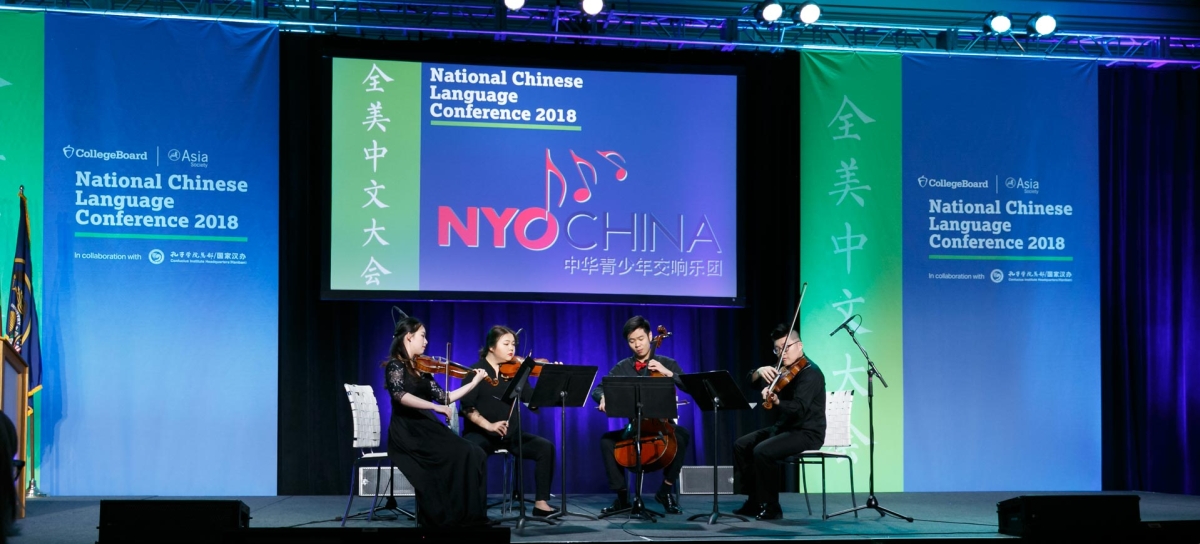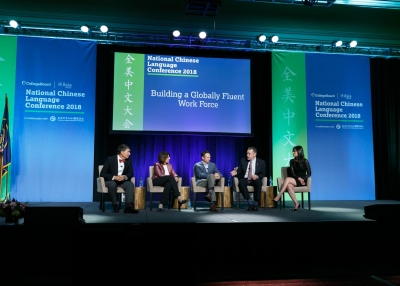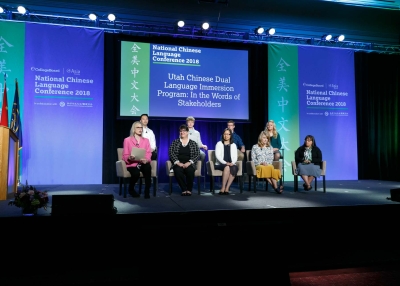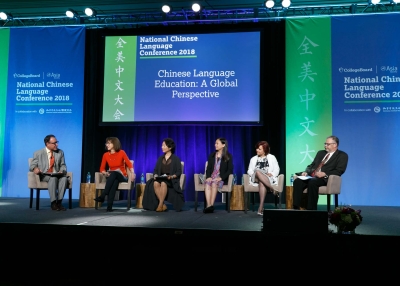From Classrooms to Careers
The 11th National Chinese Language Conference Celebrates Utah’s Key Role in Mandarin Immersion in America

By Jonathan Landreth
May 31, 2018
At a time when communication between Chinese and Americans is more important than ever, more than 1,300 educators coming from across the U.S. and the globe got a warm Utah welcome at the 11th annual National Chinese Language Conference hosted by Asia Society and the College Board, in cooperation with China’s Hanban.
Standing at a podium on stage in front of the flags of China, the United States, and Utah, Zhao Guocheng, Hanban executive deputy director-general, joined guest speakers Utah Governor Gary Herbert, State Senator Howard Stephenson, and U.S.-China Strong Foundation CEO John Holden at the Great America Hotel in downtown Salt Lake City to open the three-day gathering of workshops and networking for bilingual educators from both sides of the Pacific.
Holden, who first studied Mandarin in college in 1971, and has led a long career at the nexus of U.S.-China trade relations ever since, tipped his cap to the Chinese scholar Confucius, adapting a famous quote to draw a hearty cheer from many of the teachers around the dozens of hotel banquet tables. Speaking in fluent Mandarin and then translating for himself, Holden said: "To study Chinese and practice it often is a delight."
In keeping with the conference theme, "From Classrooms to Careers,” Holden led the audience in giving the Chinese teachers in the giant ballroom a round of applause. He then noted that the most serious students of Mandarin could delight in job offers tied to their language skills as payoff for years of hard work by gathering at the first U.S.-China Strong Foundation “China Careers Summit” at George Washington University. Holden said 101 students from 78 universities would meet their Chinese-speaking forebears in fields ranging from business and law to intelligence and academia.
Governor Herbert and Senator Stephenson both pointed out Utah’s unique position to engage China, as the home of the headquarters of the Church of Jesus Christ of the Latter Day Saints, whose adherents’ missionary work around the world is renowned. Both men come from families whose members speak myriad languages, including some who speak Mandarin, and both men worked alongside Herbert’s predecessor John Huntsman (later U.S. Ambassador to China) to effect dual language immersion legislation in Utah.
“We work around the world and live among and love the people we serve with,” Herbert said, noting Utah’s streak of independence relative to some conservative Washingtonian voices coming out against trade with China. Utah may be half a world away from China, Herbert said, but all the teachers in the room were doing good work on the “last three feet” of that journey to U.S.-China connection, “the moment when we look one another in the eye and start to communicate.”
One in five Americans studying Chinese in the United States goes to school in Utah, where there are 93 schools offering Mandarin, 47 of which are immersion schools, Herbert said, noting Utah’s disproportionate engagement with the Chinese language given how few people live in the entire state: 3.1 million. “This just shows how important Chinese has become to Utah,” Herbert said. Stephenson’s son, Daniel, not only stayed on in China for eight years after attending the prestigious Tsinhua University in Beijing, but was, in the Senator’s view, improved by Chinese for what its study taught him about compassion and empathy, not to mention employability.
Zhao Guocheng, Hanban’s top delegate to the NCLC, was helped by another of Utah’s finest, a young interpreter who stood by his side as Zhao delivered his remarks in Mandarin from the podium. “He reminds me of myself as a young man, when I studied Russian,” Zhao said, wishing the smiling interpreter well in his pursuit of a career in Sino-U.S. trade relations.
Today, there are some 100 million students of the Chinese language outside of China and 70 countries have incorporated Mandarin instruction into their curricula, Zhao said. “The United States was among the first countries to ask for Hanban’s assistance and Utah was a pioneer,” said Zhao, noting that the demand for Chinese had not yet been met, even in Utah, where the number of elementary schools offering Mandarin grew from eight in 2009 to 32 today.
In the audience, and at the NCLC for the second time, was early childhood educator Gail Foster, a graduate of Teachers’ College in upper Manhattan, New York City, and founder of the nearby Morningside PlayCare Immersion. Foster founded the Spanish-and-Mandarin immersion primary school after years of struggling to find the right place to connect her own adopted daughter, now 18, with the French of her native Burkina-Faso. “Immersion is the answer,” said Foster, a single mom who began to think about China as a next destination for her family even as she moved to educate her daughter in French in Belgium.
As an African American, Foster had been warned that Chinese attitudes about dark-skinned folks could be tough to swallow. When she and her daughter moved back to New York from Europe, she was writing a business plan for an immersion school and resolved to walk up to every Chinese person she met and speak with them to shake the perception of a cultural divide. “I’d known that China was on the rise for some time, but didn’t think I’d be doing a Chinese school until I had to write a business plan,” Foster said. “That’s how it happened. And that Chinese prejudice I’d heard about? That has not been my experience.”
At NCLC for the first time, 23-year-old Enrique Granados, assistant director of admissions of the North Andover, Massachusetts-based homestay immersion program School Year Abroad—of which he is also an alumnus of the Beijing chapter—is the son of Mexican immigrants to Southern California, who are still a bit baffled by his path to studying Chinese. Granados, a Mandarin-language major who graduated from Georgetown University, believes the whole world—not just the English-speaking parts—has become aware of China. He recalled fondly a couple of weeks volunteer work he did for the tourism board of Mexico in Beijing, his transplanted home in 2011–12. “There were a ton of Mexicans and Chinese out in Chaoyang Park together, speaking Spanish and Chinese. These are the languages. There’s a real connection between them in my mind. It’s the shortest distance. It’s so much fun,” Granados said. “The age of the sinologists interpreting China for the world is over now that China is in control of its own storytelling. Young students of China can’t be generalists and now have to understand not only the language, but have a specialization, too.”
Also at NCLC for the first time was Joyce Chen, whose family brought her to Houston from Taiwan in 1990, when she was 12 years old. Her parents owned and operated a motel and struggled with English, but Chen has been an English as a Second Language teacher in Leander, Texas independent high schools for the last 12 years, teaching mostly Hispanic students. In August, Chen’s going to teach her mother tongue for the first time. “For the last six years the school administrators have been asking me when I was going to start teaching Chinese. Now’s the time. I’ve never done it, but I’m here at the conference to learn some tools,” Chen said.
Liang Jinrong, president of Wayne Education in Salt Lake City, said he was attending NCLC in his “hometown” because the Popei International School he founded in Suzhou, China, had a lot to learn from the Utah model. “Here in Utah, the schools learned that international schools are better schools, that kids from other countries make the schools stronger,” Liang said.
NCLC co-hosts Tony Jackson (Asia Society), Linda Liu (College Board), and Jim Montoya (College Board) invoked a spirit of necessary innovation in bilingual education to adapt to new generations of language students.
Jackson highlighted a new initiative designed to support more teachers of Chinese in service of the goal to mold more “globally competent” students. In partnership with Arizona State University, Jackson said Asia Society had created a suite of 10 online professional development workshops. “Through these online courses and a deep catalog of other online resources, our goal is to ultimately reach tens of thousands of teachers across the world and, through them, four million students by the year 2030,” he said.
Liu, the Chinese-American daughter of Cantonese-speaking immigrants, described her visit earlier in the day to Salt Lake City’s own Draper Elementary as both “humbling and impressive” because the first and second graders were speaking better Mandarin than her own. Looking ahead to those young kids’ futures, Liu said that by the 2019–2020 school year, the College Board plans to roll out a series of new resources for teachers of Advanced Placement® tests, including for teachers of the Mandarin AP test. These kids, she said, are in the right place, doing the right thing for their futures. In keeping with the “Classrooms to Careers” theme, Liu did a little advance research for the kids’ families, looking for job listings that listed Mandarin as a requirement. “There are 395,000 jobs that ask for Mandarin on LinkedIn,” Liu said. “Many were teaching jobs, but increasingly Chinese is an asset in market research, finance, and all kinds of other fields.”
Montoya, introducing the evening’s final entertainment—a quartet from the National Youth Orchestra of China—also recalled his visit that day to Draper Elementary. “It was beautiful and important. First and second graders learning about different cultures. This is the best the world has to offer,” Montoya said. “Generations from now we will see many more Americans speaking Chinese. Our goal should be to listen to our students and their visions.”



